| These are the basic tools that you need for casting. Your furnace pot is the biggest expense. The Lyman Press you see here is over $350, but Lymand makes a dipper furnace much cheaper, and Lee makes both a dipper and bottom pour 20 lb. melting furnace I found on Amazon for $65, which is $30 under MSRP. At 400 degrees the lead mixture will start to smoke. This smoke is toxic and you should make sure you are in a well ventilated area. We cast outside because of a cockatiel in the house. If you have birds or other small animals beware that they cannot tolerate what humans can. Heard of canary in the coal mine? Proper casting temperature is over 800 degrees according to the casting books. A 117volt pot like this Lyman doesn’t maintain this temperature very well, so you may want to get a thermometer for precision casting so you know what you are dealing with. For indoor range fodder, as long as the lead mixture is flowing and filling the mold, it is good to go. Note that the paper sticky backs from the wheel weights have browned and blackened and will eventually turn to ash, which you can scoop out at any stage with a normal steel spoon. This is a bottom pour pot, and the ashes will never mix with the lead mixture, so scooping it out is entirely optional. I can’t say I understand the whole fluxing thing, but I do know you don’t need a lot. I do the best I can to mix in about this much with my dipper. Sometimes you can get cast bullets at a local gunshop as buying the metal ingots and casting them yourself, but you won’t be able to choose your bullet design and weight. Lee makes these six cavity molds in a bunch of sizes and weights, for just about every pistol you could think of, and they also make single and two cavity molds for everything else besides .223 caliber and below, but Lyman makes those in single cavity. Bullet casting starts simple, but it is as involved as you want to take it. There is even extensive research on the effectiveness of hard and soft case bullets on big game. Lead shrinks as it cools so make sure to overfill the sprue hole a bit. As the lead mixture hardens it will such part of the sprue down into the mold, filling out the bullet. I find the wooden handle on the sprue plate inadequate so I generally take off the wood sleeve and just knock it open. You have to keep a wrench on hand to keep the both and nut tight or the mold will get too loose, but I have never seen any degradation of the mold doing this, though you will have to speak to Lee about it voiding your warranty. Bullets never stick in the Lee six cavity molds. It could be because they never get overheated due to their size and the time it takes to fill and empty them. If you heat your mold on the lip of the furnace (NEVER DUNK YOUR MOLD), it will be hot enough to be able to use even the first casts with an aluminum mold. With steel molds this doesn’t work as well. Free wheel weights turns into shootable bullets in a very short amount of time. They aren’t perfect, little wrinkles here and there, but they will shoot just fine at indoor range distances. Next installment we will cover sizing and lubing them to load into the shells. With simple tools from Lee is is extremely easy and affordable. |
(Part two of this article is HERE.)
If you love to shoot it can get expensive. Factory ammo is not at its peak that it was during 2009 into 2010, but even cheap 9mm is still upwards of 30 cents per round. If you reload, you save the cost of the brass, and the savings are huge over factory loads, but you still have to buy the bullets. And while bullets have improved drastically over the last ten years in consistency and quality control, with these improvements have come higher prices. Spot metals on the commodity market have spiked as well, sending prices even higher. Bullets aren’t cheap anymore. You may pay almost as much for the box of bullets as you used to pay for the box of loaded ammo.
I started bullet casting about 15 years ago, and initially I treated it like some sort of black art, that only the gurus could get right. Back then you could get lead for next to nothing. Pipes were still being torn out of old houses that were made of lead, and every junkyard and tire shop had a good supply of used wheel weights, the kind with the steel clip. I tried my best to make perfect bullets with no lines in them, that all weighed the same, and I had some moderate success. But I can’t say I ever mastered that, and if I ever get back into being able to shoot BPCR (black powder cartridge rifle), maybe I’ll try again.
Recently it occurred to me that I don’t hear as much about bullet casting as I should these days. Did everyone forget about it? Jacketed bullets are too darned expensive to shoot all the time, but I like to shoot all the time, and I’m not alone. Once you start asking around, stopping in at tire places and developing a hawk eye for lead at the junkyard and flea market, you can usually get lead for free or extremely cheap. Once you buy the tools, you have them for life and they last. If you learn the basic skills of bullet casting, it could amount to a lifetime of free bullets.
Lead isn’t as available as it used to be, but I was able to easily score some wheel weights from a tire shop that had changed the type of weights they use and had a pile of these you see in the pictures lying around. It was enough to make hundreds of bullets. Yes, they do need to be sized properly and lubricated so they don’t lead the bore of your pistol, but for someone who has more time than money, the time is well worth it, both in finding the bullet material and in the casting and crafting itself. We’ll get to the rest of the process in part 2 of this series.
I’m sure you are familiar with how bullet weight is measured, in “grains.” For example, a standard lead .38 Special bullet is 125 grains. There are 7000 grains to a pound, so 7000 divided by 125 equals about 56 bullets per pound. A 230 grain .45ACP bullet would work out to 30 bullets per pound. You won’t get exactly this, but it’ll be close. Lead is pretty heavy. One pound is not a heck of a lot, so if you can score a bucket of wheel weights or a long section of old lead pipe, you could have enough lead to last you for months, or years, depending on how much you shoot.
Not Pure Lead
Generally you won’t be using pure lead, unless you are making muzzleloader bullets or shotgun slugs. Tin and usually antimony will round out most lead mixes, with a 20 to 1 mix pure lead to tin. Antimony is added to increase hardness, for “hard casting” of bullets that are supersonic, like the 9mm. Wheel weights generally have a good amount of tin in them, and they usually have some antimony too. In my experience, most guns will shoot straight wheel weights just fine. In part 2 we will look in actual mixtures and a method used in the Lyman casting book that I have yet to try that makes wheel weights hard cast without adding antimony.
Stay away from using car battery lead for bullets. From what I have read there are some potentially dangerous consequences if the wrong things are in there and you mix them with antimony. Lead mixes with tin and antimony in a permanent state. In other words, if you leave the pot sitting there for hours, heated, it will not separate, and you don’t have to stir it to keep it mixed. But some of the stuff in battery lead apparently will alter that. I haven’t tried it.
The most common lead/tin/antimony mixture is called Linotype, and there is no real standard for it, but it is commonly 84% lead, with 12% antimony and 4% tin. The word comes from the old printing press machines that are still used on many newspapers today. Each letter is lined up in a lead die made of Linotype and it is rolled on ink. The newspaper is then run over the Linotype “page” and printed. This mixture used to be so widely available that all casting books will refer to it as a household word, but you don’t hear it much today outside of the bullet casting world. I have not seen it for sale anymore in the actual letters form, but you can buy this mixture by the pound from several internet retailers.
I found a pretty good deal on Amazon for Linotype. If you up the shopping cart to 10 pounds, the price for the Linotype is $29.90, and the shipping is a total of only $14.45, so for thirty five bucks you get 300 .45ACP 230 grain bullets worth of Linotype. Not free, but at 11 cents a round, compared to jacketed bullets that are generally over 20 cents per round, it is significant savings over time. You may have a local commercial caster who sells boxes of 500 at your local gunshop, so check that out. 10 cents a round is sometimes retail these days. When you cast your own you can pick your bullet as well, not just your price, but for blasting fodder who cares. Convenience and price are the main things.
The Tools for the Job
If you look in the pictures, you will see that I am using a Lyman 20 pound pot that has a bottom pour spout. Next to the pot you will see my dipper. Those are the two ways of getting the lead into the mold (or mould depending on where you hail from). With a bottom pour you pull the stopper while holding the mold under the spout, and with a pot that has no spout, you dip out some lead mixture and tilt it into the holes in the swinging “sprue cutter” plate connected to the top of the mold. This fills out the mold and pushes the air out from between, leaving you with a perfect, or close to perfect, bullet. There are Lyman dipper pots starting at $39, and Lee makes a bottom pour currently on Amazon for $65 that is very good and probably the best buy in a melting pot today.
As you can see, my only tools here are my pot, my dipper, a wooden stick, a towel and some flux compound I got from Midway. The thermometer is optional since I will give you the basic temps here where things happen. Bullet casting isn’t rocket science. Maybe to do it perfectly right for long range accuracy there are a lot of details you must learn, but these pictures are proof that you can just plug in the pot, throw some wheel weights in, let them melt, and cast yourself perfectly functional bullets. I let my mold heat up on that little shelf as the pot heats, and this Lee mold is aluminum, so it acts as heat sink and gets hot as quickly as the pot. You may want to thrown your first bullets back into the pot, because the first ones serve to heat up the mold to operating temperature, but I am able to use the first ones when I heat the mold in this manner.
The six cavity Lee molds are not the tool of a true bullet crafter. Generally someone who is aiming for the best bullet possible will use a single cavity, or at most a two cavity mold. The six cavity mold is only made by Lee, and it saves you so much time that the disadvantages of it are outweighed by the sheer convenience. These disadvantages are primarily that the bullets are never perfect, because the mold cools off too quickly as you are filling it, so by the time you dump the six bullets out, the first cavities have cooled off. Notice that my bullets do not have perfectly sharp edges. If I rush so that the mold has less time to cool I can get them sharper, but why rush? Most of my shooting is for fun at indoor range distances with friends. If I want to test the accuracy of a pistol I’ll use jacketed Hornady bullets thank you very much, not the theoretically perfect hand cast bullet. There are so many variables in casting, you aren’t going to get it perfect anyway, so I say save the time and use the six cavity.
I have several of these Lee molds and I have never had one of them fail to drop the bullets without having to be hit, which I can’t say of some expensive steel single cavity molds. The pins on the Lee are set into a steel sleeve, not directly into the aluminum, so the mold stays true even with thousands of bullets cast and thousands of times striking the sprue plate to get the bullets out. Just keep the screw heads tight because they do get loose.
Also note that these Lee molds do not come with handles. There is a picture on the box with handles, and you’d swear that the box is made for handles, and it even has a compartment for handles, but generally they do not come with handles. You have to separately order part number 90005.
For such simple casting, flux may or may not be needed. Simple beeswax works fine, and ideally you scoop air in while stirring the flux with your dipper according to the Lyman casting book. It is supposed to make inconsistencies and gunk separate out from the lead and float to the top. I personally haven’t been able to figure out how you mix the flux in. It kind of just floats, no matter what you do, but I guess it must do something.
You can see from the pictures that I was able to get some of the sticker-type wheel weights that are used for mag wheels, because the steel clip kind scratch the wheels. They have a sticky back that I didn’t bother to try to get off before throwing them in the pot. You don’t need to, it separates and burns and floats to the top, no flames or drama. It just turns black and grey. I use a long spoon to scoop it out, but with a bottom pour pot you don’t have to even do that. You can just tilt the pot at the end and let the pot cool, then take out the hardened mass of a little left over lead mix. The foreign material doesn’t bond with the lead. You can just dump it right out and use the lead chunk in your next batch. The same is true of the steel clips on the old kind of wheel weights. They will float to the top as soon as the lead alloy melts, and you can just scoop them out.
Safety
This article is not an instruction on how to cast bullets. It is merely an example of how easy it is to cast bullets when you learn the basics, and some examples of the money you can save. Please buy the Lyman bullet casting book. It is very good. Never cast without safety glasses, don’t wear open shoes or open shirt, and use heavy leather gloves. Lead casts at over 800 degrees and just a drop of it will really ruin your day. I personally cast outside because we have a cockatiel in the house, but no matter what you should make sure you have plenty of ventilation. Lead fumes are nasty, and there is no escaping the fumes that drift out of the pot.
Never have any water near the pot, ever. Even a small amount of water in your pot will sink to the bottom, boil, and cause a steam explosion of molten lead, and while this might be a nifty thing to watch on Youtube, you certainly don’t want to be around if such a thing should occur. BE CAREFUL and DON’T DO ANYTHING STUPID! Leave that for the experts.
With these simple instructions and the pictures here to guide you, it should be pretty simple to get to the point where you have a pile of cast bullets in hand. If all you can get is pure lead, like old water pipes or diving weights, the metal recycling places and junkyards generally have tin and antimony. Plug “scrap metal” into maps.google.com after you put in your address and it will show you the closest people to call.
If you can’t get lead, tin, or antimony locally, you can also get them on Amazon in 1 pound ingots, and from other internet retailers. It will bring up your cost, but if you are frugal, over the years you will find plenty of free lead, wheel weights, and even tin. The furnace, bullet mold and dipper will last you a lifetime, even though the steel will most likely rust after you use it the first time. I have made and shot thousands of bullets for free, and you can too.
In the next installment we will look at hardness and mixes, and a trick from the Lyman casting book using your home oven to save you the money on antimony. We may even get to sizing and lubing, both made extremely easy thanks to the brilliant folks at Lee. Hopefully as we go down the road we’ll be able to cover a lot of casting topics. Casting perfect is really hard, but casting ok enough to get by is easy, and you get a whole bunch of free or cheap bullets.
(Part two of this article is HERE.)


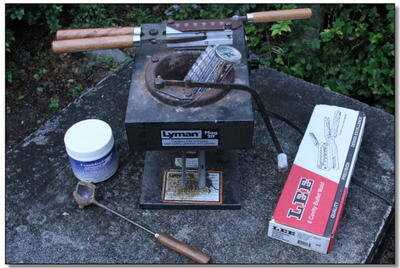
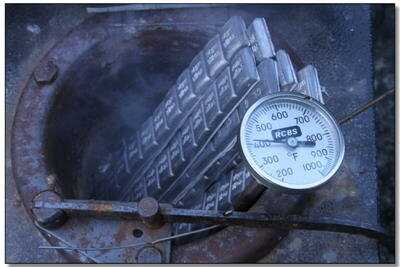
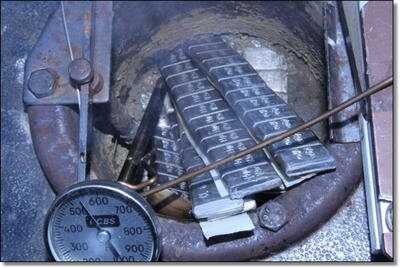
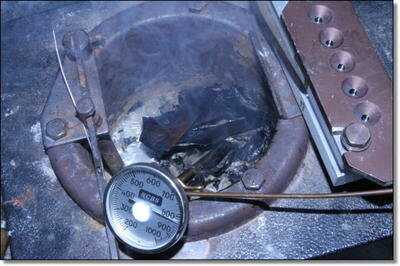
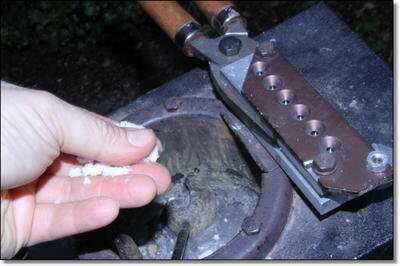
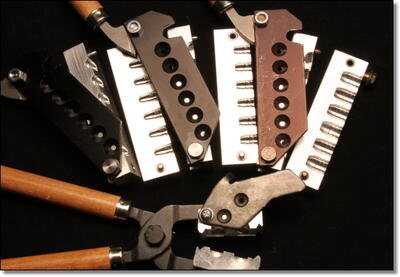
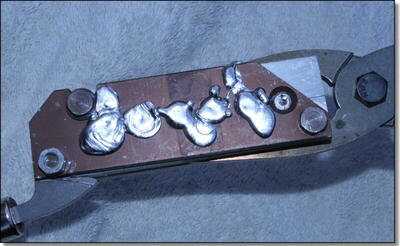
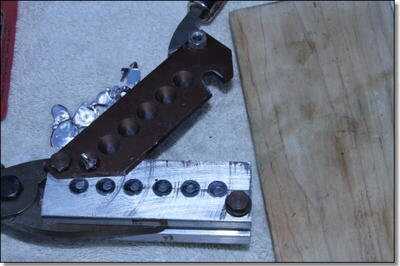
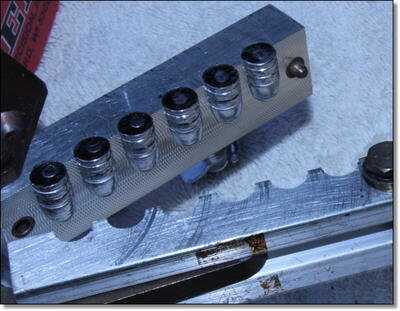
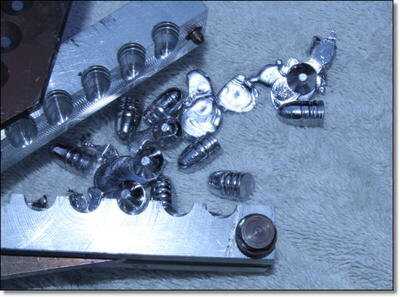
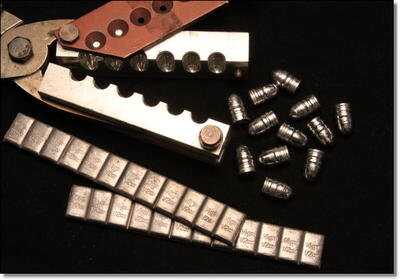

Is there someone that can tell me what I’m doing wrong? I’m trying to cast pure lead bullets for black powder. I constantly get this gooey crap floating on the surface of the lead. It’s blue-purple-red when the lead is cooler and goldish when it’s hotter. I scrape and scrape it off the top and its infinite. I tried for 3 hours today and ended up with about 4 pounds of the stuff mixed with lead thrown into the coffee can “garbage” receptacle. It kinda acts like ashes when it’s more pure with little lead mixed in it. I’ve tried fluxing between 2 to 8 times, using beeswax, oil made from beeswax, paraffin wax, and candle wax. I’ve used anywhere from a couple drops to a teaspoon. I’ve tried cooler lead and hotter lead. I’ve used lead from three different distributors and nothing makes any difference. I’m frustrated and ready to throw the whole thing in the trash. What am I doing wrong?
Trying running it a little cooler. Probably just oxidation. Or you have zinc or something in there, or it’s lead from a car battery or something else weird.
I am pretty sure you got bad lead (contaminated with Zinc or something else) I got same thing lead I bought from scrap yard. I suggest you put that lead aside and get a different lead. I heard you can clean up contaminated lead with sulfur powder but it will also clean out other useful metals like tin and arsenic and it stinks bad, might be cheaper to just buy different lead from eBay or get your hands on wheel weighs.
Isn’t it funny that the very folks who say don’t use car batteries (the ammo manufacturers) are the very ones that do use car batteries. Protecting their supply to charge you more for the very thing they say “don’t use”.
For the best information on casting bullets as well as reloading same, go to youtube and search for FortuneCookie45LC.
His uncatalogued is around 650+ videos, predominantly casting and reloading.
my comment is that if you want good lead go to a gun range and pick up all the old spent bullets you want
Your post is really well written. The examples which you mentioned for “Free Bullets for Life – Bullet Casting 101 Part 1” are perfect. I am looking forward to your next post 🙂
I really enjoyed reading this. I too, have been thinking of casting and reloading. Very informative for me. Thank you.
When he says absolutely no water in the pot, he means it. I experienced a steam explosion when I knew better than to mix water (just a couple of drops) and the molten lead. You would have thought someone set off a great big firecracker in the bottom of the pot. I’ve worn glasses since I was in the 2nd grade, and thank God for that. I had bits of lead stuck in my forehead, stuck to my hat, and stuck to the ceiling in the kitchen where I was doing the casting- Oh yeah, that’s another really really stupid idea. NO CASTING IN THE KITCHEN! …even if you are a bachelor.
I moved the whole operation to the garage. Now I open the upwind and downwind doors and have a fan just the other side of the casting “bench” from where I stand, pulling the fumes away from me and the molten lead.
Could I use old bullets dug up in the shooting berm? I heard that you could melt the old bullets and all the old jacketing material can be scooped out from the top. Not sure about all the different bullets and their mixtures.
Yes we are going to try to cover that in the next article and score some range lead from a local indoor range.
Great Article…
I wish there were a PDF of the article to reference off-line. It helps in building an electronic library and a “To-Go” file on my phone to reference off location or in conversation with others.
Just a thought
I thought I had missed part 2 as well, guess it is just taking a little longer than expected. Can’t wait to read about sizing! I am having issues right now with that particular topic.
Thanks!
The problem with writing about sizing is that there are such differences in “as cast” diameters based on what hardness you are using. It isn’t a simple thing, but we are working on it.
Hope it is coming soon, I am almost ready to start casting. I tried it years ago, but ran out of time with the jobs I was working. Am retired now and ready to start again. Thanks
I somehow missed part 2 of this article and would very much like to read it. Can anyone help me?
Part two should be out next week.
Thank You, I look forward to it!
It is a month later, and still no part 2, did I miss it or have you not posted it yet.
It should be out this week. The research took a couple interesting twists.
This is great stuff. I actually thought about it once and honestly just didn’t think much of it. But with prices for even the “cheap” ammo going higher and higher, this is a great way to save a lot. Great article.
My only problem with this article, and it is really a small one, is that I have been completely unable to locate any of the mythical ‘free’ lead I always hear about. I’ve called ever tire dealer in the area, and not one of them is willing to part with their old wheel weights!!! Scrap yards, construction sites, NADA! I’ll keep looking, but I hope others are having better luck than I am. Can get 68lbs for around $130 on Ebay though….
Go here for more information, and check out their vendors/swapping and selling section for better prices on Lead and alloys.
$1.00/lb. DELIVERED for bullet metal is better than $3.50…
“Cast Boolits”
http://castboolits.gunloads.com/index.php
http://castboolits.gunloads.com/forumdisplay.php?f=18
Los Angeles Silhouette Club has a lot of good casting information-
http://www.lasc.us/IndexBrennan.htm
And for people who simply must spell “bullet” corectly…
http://www.castbulletassoc.org/forum/
Very timely article for us. My son and I are just about to get into hand loading and reloading and while I hadn’t really thought I would want to try and and cast my own bullets, I now see that I will after all, if not at first, then after we get cranking on the first part for sure. “Thanks” for the info! We’ll get the Lyman book as well. And I recently got their catalog which has lots of goodies.
I’ve been casting for over 30yrs and I’ve made some pretty fine bullets1 For pistol loads, regular wheel weights are fine. Once You get to magnum velocities, I hard cast(by dropping in Water) and use gas checked moulds with appropriate cal. gas checks.
The same is true for rifle bullets.
The “water drop method” adds to the hardness. Up to about a 15 on a Brnl. scale. Add more antimony or Linotype and without “heat treating” (in your oven) You can get nearly to the mid 20’s on the same scale, but the bullets then become “frangable”- sometimes that’s good, sometimes Not. Depends on the application to be used.
The basic premise of the article is true. You CAN make perfectly shootable loads useing cast bullets, cheap. The truth is You can make Great loads as well. How involved You want to get is the limiting factor.
One more thing; Hard cast bullets with gas checks can be driven at the same speeds as jacketed (at Handgun velocities) with LESS chamber pressure- even in .454’s and .460 S&W’s. And DO buy the Lyman Book- It’s the Bullet Caster’s Bible.
Very well done article, I might have just discovered a new hobby. I’ve got a bucket of lead I’ve been saving for years, cast net weights and wheels weights and such. Thought I would eventually cast some fishing weights with them but bullet making sounds more practical and I love to shoot my guns when I can.
I need a mold for a .302 dia. 80-90 gr bullet. Anyone got an extra one?
I thouroughly enjoyed reading and learning from your article. With today’s prices for ammo, the old school way can save us
quite a bit of money. A point I would like to make has to do with lead vapors. It’s not only bad for “Scooter” (I own a Mollucan and Umbrella Cockatoo),
it is also poisonous to us. Ideally a gas mask would be the best protection while working with molten lead. An alternative would be
using the very best face mask you can buy.While a surgical mask is not as effective as a gas mask, it still would cut down the amount of lead our lungs would be exposed to, and it is much more practical. Once in your lungs, we do not have the ability to remove lead; and it could cause serious problems over the years of exposure. The bottom line is we have too be as safe with lead vapors, as we are with are handguns. Safety always comes first!
My boyfriend’s dad and him did lead casting all the time when he was a child. I wonder if that is what is wrong with them both? Goofy, and Goofy Jr. Makes the most consistent clean shooting loads I could want.
Plumbers lead was pure lead. I made 1# ingots half pure lead and half wheel weights.
Started in 1962,Try to shoot 500 or more a week,they very well rifle and pistol.
Still have about 850# to teach soninlaws and grandsons.
It is a great hobby,
Just an extra warning about water and lead pots. This only applies to molten lead. And it applies to any liquid with a lot of water in it — as my father the plumber said to me “Never spit in the lead pot.” (It had never crossed my mind that anyone would want to spit in a lead pot until he said that!) The water doesn’t sink to the bottom, but vaporizes on contact with the surface, causing a steam explosion and flying hot lead. Even if the lead solidifies in the air, it is till several hundred degrees Fahrenheit and will burn or melt through cloth, thin plastic, etc. I have seen small lead pot blows and it is pretty scary, and NO, I did not spit in the pot — it was from snow on the scrap lead we were re-melting!
Excellent article. You have gotten me to seriously look at bullet casting since I have been reloading for SASS cowboy action shooting.